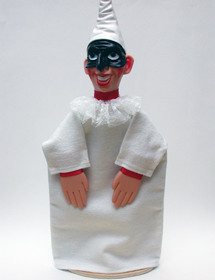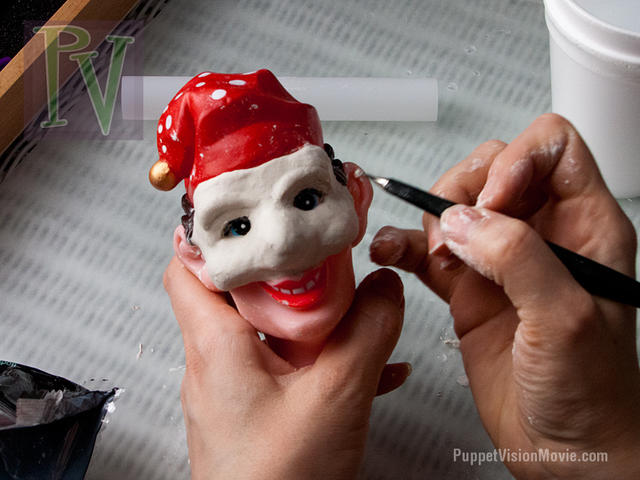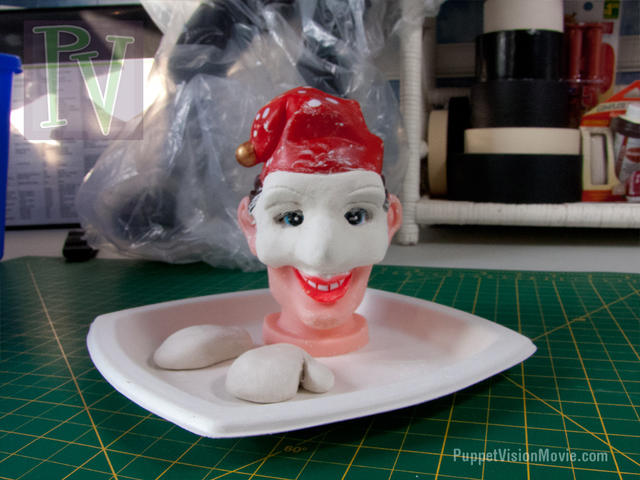Making a Pulcinella Hand Puppet Posted by Andrew on Mar 11, 2014
I haven't done much hands-on puppet building for almost three years, but I have a lot to do this year with the help of a small team and I thought it would be fun to share some of our work as we go and get some feedback here on the board.
We finally got our new studio/office set-up over the weekend - which was a two month part-time undertaking - and we have to build an insane number of puppets (probably 40-50) in just about every style imaginable for the "PuppetVision" documentary before the end of the year. One of the first projects on our plate is a set of Punch and Judy hand puppets that includes just about every regional variation on Punch there is (Punch, Kasperl, Pulcinella, etc.).

Above is an example of a Pulcinella puppet that's mass produced in Italy. For anyone who does know, Pulcinella is sort of the ancestor of Punch (of Punch and Judy fame).
We've got so much to build that we've been looking for ways to save time wherever we can. While discussing the best way to sculpt and cast a Pulcinella hand puppet yesterday I remembered that I had an old rubber puppet head that's been sitting in a box in the studio for two years. I remembered a tutorial I'd shared on my blog a couple years ago that involved "upgrading" an old rubber Punch puppet so we decided to try it ourselves to make Pulcinella.

The first step is to sculpt Pulcinella's mask on the rubber puppet head using Paperclay. I don't know if many people here on the board use paperclay, but puppeteer/director Sam Hale turned me on to it last year (he uses it in all his films) and it's a fantastic material. Once it air dries it can be sanded, or even re-activated by applying water.

Here's a photo of the first pass at the head. Once it dries we'll clean it up and add a little more detail.
You can also see the puppet's hands; they were sculpted as an experiment. We might end up carving them from a light weight wood like bass wood.

A side view the head as it dries.
More photos soon, feedback is welcome and most appreciated!
We finally got our new studio/office set-up over the weekend - which was a two month part-time undertaking - and we have to build an insane number of puppets (probably 40-50) in just about every style imaginable for the "PuppetVision" documentary before the end of the year. One of the first projects on our plate is a set of Punch and Judy hand puppets that includes just about every regional variation on Punch there is (Punch, Kasperl, Pulcinella, etc.).

Above is an example of a Pulcinella puppet that's mass produced in Italy. For anyone who does know, Pulcinella is sort of the ancestor of Punch (of Punch and Judy fame).
We've got so much to build that we've been looking for ways to save time wherever we can. While discussing the best way to sculpt and cast a Pulcinella hand puppet yesterday I remembered that I had an old rubber puppet head that's been sitting in a box in the studio for two years. I remembered a tutorial I'd shared on my blog a couple years ago that involved "upgrading" an old rubber Punch puppet so we decided to try it ourselves to make Pulcinella.

The first step is to sculpt Pulcinella's mask on the rubber puppet head using Paperclay. I don't know if many people here on the board use paperclay, but puppeteer/director Sam Hale turned me on to it last year (he uses it in all his films) and it's a fantastic material. Once it air dries it can be sanded, or even re-activated by applying water.

Here's a photo of the first pass at the head. Once it dries we'll clean it up and add a little more detail.
You can also see the puppet's hands; they were sculpted as an experiment. We might end up carving them from a light weight wood like bass wood.

A side view the head as it dries.
More photos soon, feedback is welcome and most appreciated!
Re: Making a Pulchinella Hand Puppet Posted by Na on Mar 11, 2014
Wow! I really love Pulcinella! He looks so much like the traditional clown costume that you imagine when you think of Pulcinella, and a great example of the later Punch glove puppet. So great 
You'll have to email me a reminder when your movie is ready for viewing.
EDIT: Pulcinella or Pulchinella? I've only ever seen it without the h. Wikipedia uses the one with no 'h'....
You'll have to email me a reminder when your movie is ready for viewing.
EDIT: Pulcinella or Pulchinella? I've only ever seen it without the h. Wikipedia uses the one with no 'h'....
Re: Making a Pulchinella Hand Puppet Posted by Shawn on Mar 11, 2014
Very cool! I think I had one of those heads when I was a kid.  Yep I use paperclay and you are right it is a fantastic product, very easy to work with.
Yep I use paperclay and you are right it is a fantastic product, very easy to work with.
Re: Making a Pulcinella Hand Puppet Posted by Andrew on Mar 11, 2014
The only issue I've found with Paperclay is that it tends to shrink a bit while drying, which often leads to cracks.
Also, is it just me or does it not seem to hold details as well as oil based clays? You can always carve details in once it dries (which is neat), but it doesn't seem to texture terribly well.
Also, is it just me or does it not seem to hold details as well as oil based clays? You can always carve details in once it dries (which is neat), but it doesn't seem to texture terribly well.
Re: Making a Pulcinella Hand Puppet Posted by Andrew on Mar 11, 2014
Posted by: Na on Mar 11, 2014
EDIT: Pulcinella or Pulchinella? I've only ever seen it without the h. Wikipedia uses the one with no 'h'....I've actually seen it spelled both ways, but I'm pretty sure "Pulcinella" is correct (it means "little chicken" in Italian). That was just an autocomplete error/typo.
Re: Making a Pulcinella Hand Puppet Posted by Na on Mar 11, 2014
Posted by: Andrew on Mar 11, 2014
I've actually seen it spelled both ways, but I'm pretty sure "Pulcinella" is correct (it means "little chicken" in Italian). That was just an autocomplete error/typo.
Ah, ok. Funny though, I've never seen it spelled that way. Wonder if it's one of those English/American things.
Re: Making a Pulcinella Hand Puppet Posted by Shawn on Mar 12, 2014
Posted by: Andrew on Mar 11, 2014
The only issue I've found with Paperclay is that it tends to shrink a bit while drying, which often leads to cracks.Yes cracking can be an issue but I've found that if I use thinner layers and build up it helps with that.
Also, is it just me or does it not seem to hold details as well as oil based clays? You can always carve details in once it dries (which is neat), but it doesn't seem to texture terribly well.
I've never done much texture detailing with it so had not noticed that really. Most my applications of it have been in faces and never had a problem with it holding the detail I wanted for that. Again I tend to build up in layers or use a thin layer over a styro base with paper mache' cover.
Re: Posted by DrPuppet on Mar 12, 2014
This is great stuff Andrew I'm glad to see you are building again.
Sent from my SAMSUNG-SM-N900A using Tapatalk
Sent from my SAMSUNG-SM-N900A using Tapatalk
Loading
No More Post
Error
Loading